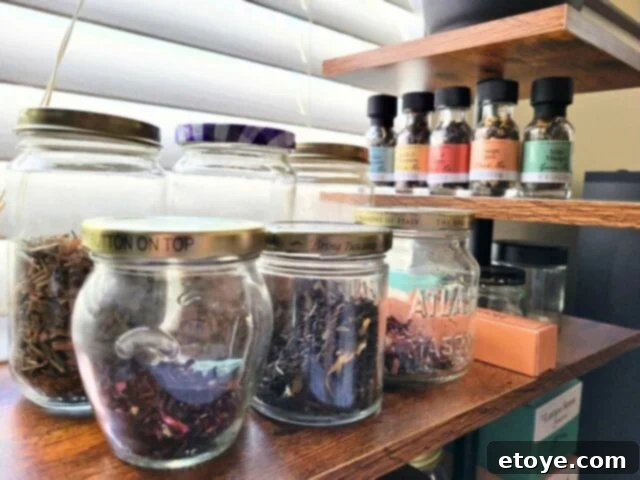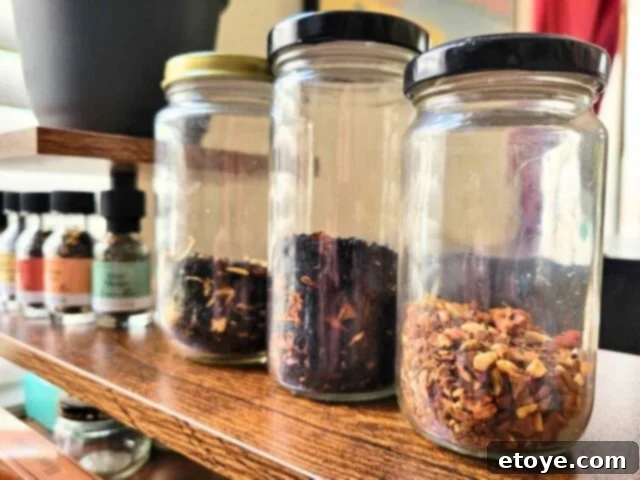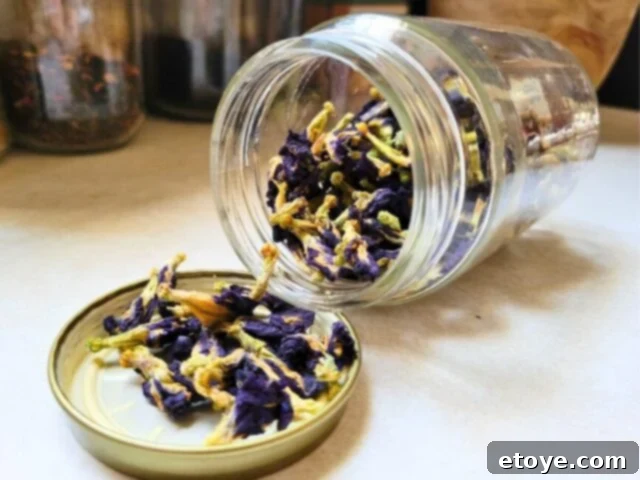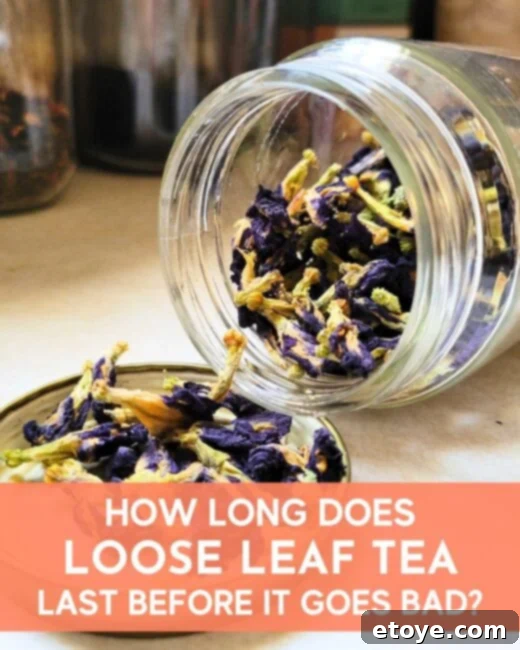For many of us, tea is more than just a beverage; it’s a cherished ritual, a moment of calm, and a source of comfort. Whether you boast an impressive collection of rare loose-leaf teas or simply enjoy a comforting cup from time to time, a common question often surfaces: how long do these wonderful tea leaves truly last?
It’s a valid concern shared by tea connoisseurs and casual sippers alike. Understanding the shelf life of your tea isn’t just about preventing waste; it’s crucial for preserving the exquisite flavors, delicate aromas, and beneficial properties that make each cup special. Dive with us into the fascinating world of tea storage and longevity, and unlock the secrets to enjoying your favorite brews at their peak.

Understanding Tea Shelf Life: How Long Do Your Favorite Brews Really Last?
The quest for the perfect cup begins long before the water boils. It starts with the quality of your tea leaves and how well they’ve been preserved. While tea doesn’t typically “expire” in a way that makes it harmful to drink (with rare exceptions), it certainly loses its vibrancy, aroma, and flavor over time. The ultimate goal is to maintain that fresh, robust character you fell in love with.
The Lifespan of Tea Leaves: A Detailed Guide by Type
Pinpointing an exact expiration date for tea is challenging because it varies significantly based on the tea’s type, processing, and how it’s stored. However, we can provide a general framework to help you gauge the longevity of your beloved leaves.
General Rule of Thumb
Most loose-leaf teas, when stored correctly, can retain their best quality for anywhere from 6 months to 3 years. Bagged teas, often finely cut, may have a slightly shorter shelf life due to increased surface area exposed to air, typically around 1-2 years. Let’s delve into the specifics of each tea category.
- White Tea and Green Tea: Delicate Divas with a Shorter Prime
These minimally oxidized teas are prized for their fresh, vibrant, and often grassy or floral notes. Their delicate nature means they are more susceptible to degradation than their more oxidized counterparts. To truly appreciate their subtle complexities, white and green teas are best enjoyed within the first 6 to 12 months of purchase. While some premium white teas, like Silver Needle, are occasionally aged for up to 24 months, careful storage is paramount. Green teas, such as Japanese Sencha or Chinese Dragonwell, typically maintain optimal flavor for up to 18 months, but their peak freshness is often within the first year.
- Oolong Teas: The Spectrum of Longevity
Oolong teas fall between green and black teas in terms of oxidation, resulting in a wide spectrum of flavors and, consequently, varying shelf lives. Lighter, greener oolongs (like a high-mountain Ali Shan) share some fragility with green teas and are best consumed within 1 to 1.5 years. Darker, more oxidized oolongs (such as a roasted Da Hong Pao or Bai Hao) possess greater stability and can last 2 to 3 years, sometimes even longer, developing richer, more complex notes over time if stored meticulously.
- Black Tea: Robust and Resilient
Fully oxidized, black teas are the most stable and forgiving of the “true” teas. Their robust flavor profiles and heartier structure allow them to maintain excellent quality for 2 to 3 years when stored properly. Popular varieties like Assam, Darjeeling, Ceylon, or Earl Grey are excellent choices for stocking up, as they hold their character well over an extended period.
- Pu-erh Teas: The Ageless Wonder of the Tea World
Often referred to as the “wine of teas,” Pu-erh stands out for its unique ability to improve with age. Both raw (Sheng) and ripe (Shou) Pu-erh teas are specifically processed to evolve over time, with some prized cakes developing incredible depth and complexity over decades, even centuries. Many enthusiasts intentionally purchase young Pu-erh to age it in their own collections. Proper storage conditions are critical for successful aging, ensuring the tea develops desirable characteristics rather than simply spoiling.
- Herbal Teas (Tisanes): Nature’s Diverse Offerings
While not technically “tea” (as they don’t come from the Camellia sinensis plant), herbal infusions or tisanes are a popular category. Their shelf life largely depends on their ingredients. Most herbal teas, such as chamomile, peppermint, rooibos, or fruit infusions, generally last 1 to 2 years. Dried herbs, flowers, and fruits can lose their potency and flavor over time. Check the specific ingredients; roots and bark might last longer than delicate flower petals.

Key Factors Influencing Tea Longevity: Preserve Your Brew’s Perfection
Beyond the inherent characteristics of each tea type, several environmental factors play a critical role in how long your tea leaves retain their quality. Mastering these elements is key to extending the life of your tea.
1. Proper Storage: The Foundation of Freshness
This is arguably the most crucial factor. Tea is highly sensitive to its environment. To maximize its lifespan, store tea in an airtight container such as a ceramic tea caddy, a dark glass jar with a tight-fitting lid, or a metal tin. These containers create a barrier against the elements that cause degradation. Always keep your tea in a cool, dark place, away from direct sunlight and any sources of heat or strong odors.
2. Air Exposure and Oxidation: The Silent Flavor Thief
Oxygen is the primary enemy of fresh tea. Exposure to air accelerates the oxidation process, breaking down the delicate essential oils, catechins, and other volatile compounds responsible for tea’s unique flavor and aroma. The more frequently your tea is exposed to air (e.g., repeatedly opening a large bag for a single serving), the faster it will lose its potency. This is why airtight containers are non-negotiable for preserving freshness.
3. Type of Tea: Inherent Oxidation Levels
As discussed, the processing method and level of oxidation inherent in different tea types fundamentally dictate their initial shelf life. White and green teas, being minimally oxidized, degrade faster. Black teas, fully oxidized, are more stable. Pu-erh teas are unique, designed to undergo beneficial aging.
4. Temperature and Humidity: The Accelerators of Decay
High temperatures can cause the delicate compounds in tea to degrade rapidly, leading to a loss of flavor and aroma. Humidity is equally detrimental, as moisture can encourage mold growth and spoilage. Always store tea at a stable room temperature, ideally between 60-75°F (15-24°C), and in a dry environment. Avoid storing tea near appliances that generate heat or steam.
5. Light Exposure: UV Damage
Direct sunlight, and even strong artificial light, contains UV rays that can break down the sensitive chemical compounds in tea leaves. This degradation can lead to a faded appearance, a loss of beneficial antioxidants, and a diminished flavor profile. Opaque containers are essential for shielding your tea from light damage.
6. Quality of Tea: A Strong Starting Point
The initial quality of your tea leaves significantly impacts their potential longevity. Higher-quality, whole-leaf teas, especially those with fewer broken pieces and less dust, contain more intact essential oils and cellular structures. This robustness allows them to retain their flavor and aroma for a longer period compared to lower-grade teas or fannings often found in tea bags, which have greater surface area and are more prone to rapid degradation.

Identifying Spoiled Tea: Signs Your Brew Has Lost Its Luster
Sometimes, despite our best efforts, tea can lose its freshness or even go bad. While drinking old tea is rarely harmful, it certainly won’t deliver the delightful experience you seek. Here’s how to tell if your tea leaves are past their prime.
1. The Ol’ Sniff Test: Aromatic Clues
Your nose is your first and best tool. Fresh tea, especially loose-leaf, should possess a distinct and often complex aroma. If your tea smells flat, musty, dull, or has no scent at all, it’s a clear indication that the volatile oils have evaporated, and the tea has lost its potency. Conversely, if it has developed an “off” or sour smell, it could be a sign of moisture or spoilage.
2. Visual Inspection: Color, Texture, and Unwanted Guests
- Color: Fresh tea leaves typically boast vibrant, natural colors. If your tea looks faded, dull, discolored (e.g., green tea turning brown), or has developed unusual white or grey spots, it’s time to be wary.
- Texture: Tea leaves should feel dry and brittle. If they feel damp, soft, or clumped together, it indicates moisture exposure, which can lead to mold.
- Mold: Any visible fuzzy white, green, or black spots are a definitive sign of mold. Immediately discard the tea, as consuming moldy tea can be harmful.
- Pests: Infestations by pantry moths or other insects are possible if storage conditions are compromised. Look for tiny holes in leaves, webbing, larvae, or droppings. If detected, discard the entire batch.
3. The Taste Test: The Ultimate Verdict
If your tea passes the sniff and visual tests but you’re still uncertain, a small taste test can confirm its status. Brew a small amount. If the tea tastes bland, flat, excessively bitter, excessively sour, metallic, or simply “off” in any way, it has likely lost its prime. Remember, true Pu-erh tea develops complex earthy notes with age, but this is distinct from the unpleasant, stale taste of expired conventional tea.
4. Check Expiration or Best By Dates
While many loose-leaf teas don’t come with strict expiration dates, packaged teas often feature “Best By” dates. These indicate the period during which the tea is expected to be at its peak quality. While safe to drink past this date, the flavor and aroma will likely have diminished.
5. Signs of Moisture: Clumping and Dampness
As previously mentioned, moisture is tea’s arch-nemesis. If you notice your tea leaves have clumped together, feel damp, or if there’s any visible condensation inside the container, it’s a strong indicator of moisture ingress. This can quickly lead to mold and spoilage, so it’s best to discard it immediately.

Maximizing Your Tea’s Freshness: Essential Tips for Every Tea Lover
Armed with knowledge about shelf life and spoilage, here are practical tips to ensure every cup you brew is as fresh and flavorful as possible.
- Buy in Smaller Quantities: Especially for delicate teas like green and white, or if you’re an occasional drinker, purchasing smaller batches ensures you’ll consume the tea while it’s still at its peak. This minimizes the risk of it losing flavor before you finish it.
- Invest in Quality Airtight Containers: This cannot be stressed enough. Opt for opaque ceramic caddies, dark glass jars, or food-grade metal tins with tight-sealing lids. Avoid clear containers unless they are stored in a dark cabinet.
- Label and Date Everything: Develop a habit of labeling your tea containers with the date of purchase or the “best by” date. This simple practice helps you keep track of your inventory and prioritize which teas to drink first.
- Keep Tea Away from Strong Odors: Tea leaves are highly absorbent and can easily pick up surrounding smells. Store your tea away from spices, coffee, cleaning products, or anything with a strong aroma that could taint its delicate flavor.
- Avoid Refrigeration or Freezing (Generally): While some specific Japanese green teas might benefit from careful, airtight freezing, it’s generally not recommended for most teas. The condensation that occurs when removing tea from the cold environment, coupled with the potential for odor absorption, can do more harm than good. Room temperature, dry storage is usually best.
- Understand Surface Area: Loose-leaf tea, while offering superior flavor, has more surface area exposed to air than tea bags (which are often fannings or dust). This means loose-leaf tea requires more diligent storage to maintain freshness.
- Prioritize Health Benefits: The beneficial antioxidants and polyphenols in tea are most potent when the tea is fresh. As tea ages, these compounds can degrade, diminishing the health benefits. Drinking fresh tea ensures you’re getting the most out of every healthful sip.

It’s Tea Time! Savor Every Moment
All this talk of tea certainly makes one yearn for a comforting cuppa. For many of us, tea is far more than a simple beverage; it’s a cherished ritual, a soothing embrace, an invitation to pause and reflect. It’s an opportunity for mindfulness, perhaps gratitude, or simply a moment of quiet contemplation. Whatever it signifies for you, we can undoubtedly agree that tea offers an experience, a chance to truly savor the present moment.
By understanding the nuances of tea shelf life and implementing smart storage practices, you empower yourself to consistently enjoy your favorite brews at their peak. No more wondering if that forgotten tin in the back of the pantry is still good; you’ll have the knowledge to ensure every cup is a fresh, flavorful delight.
What about you? What makes tea so special in your life? Do you have a go-to favorite, perhaps a robust black tea to start your day or a calming herbal blend for the evening? Are you a dedicated loose-leaf connoisseur, or do you appreciate the convenience of tea bags? Share your thoughts, your favorite blends, and any unique tea additions or food pairings you enjoy in the comments below! We always love to hear from our fellow tea enthusiasts.
